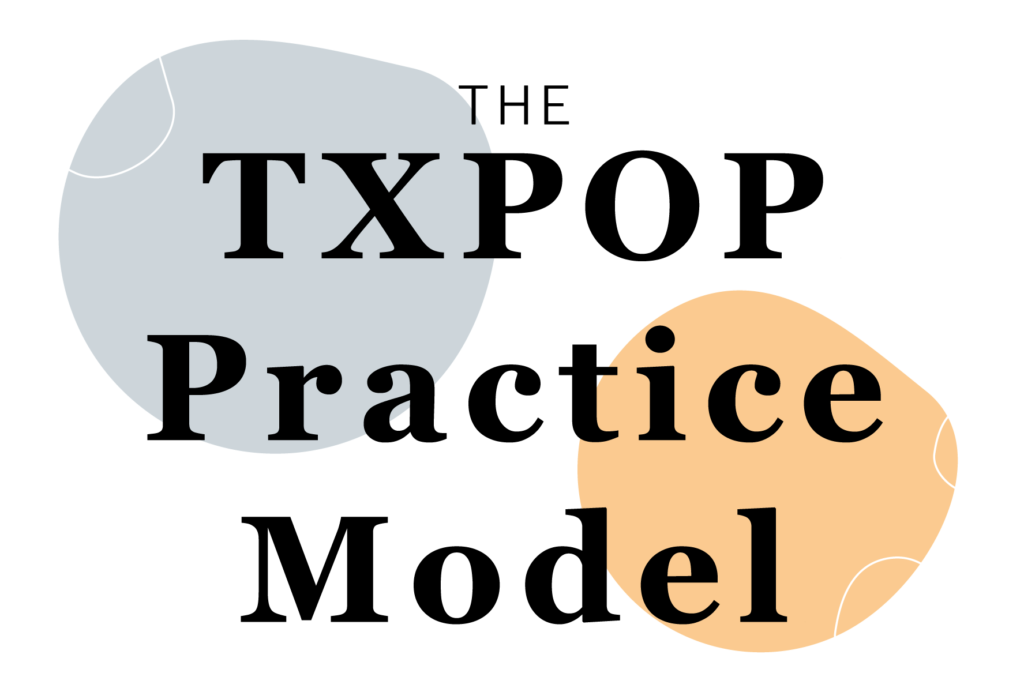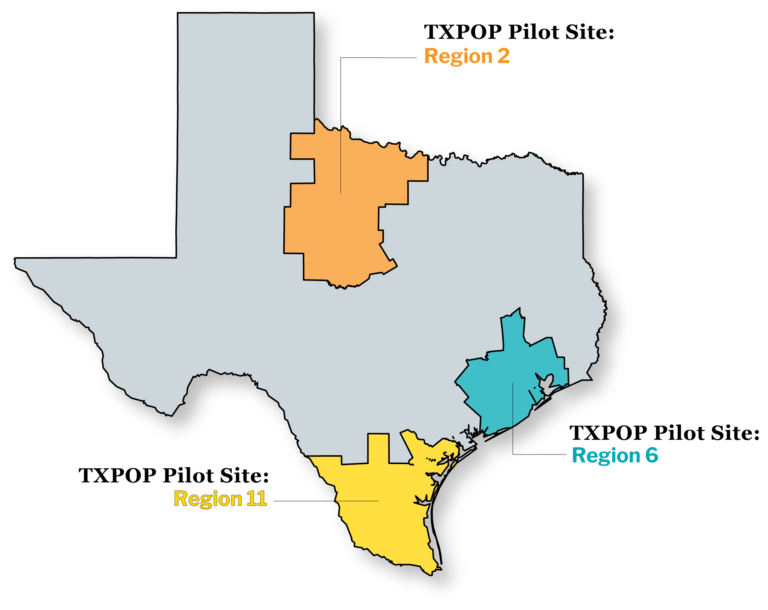

TXPOP is creating a new practice model to help child welfare agencies engage families in planning and decision making, build partnerships between families and foster caregivers, and increase children’s sense of belonging. By implementing innovative strategies that put children’s voices at the heart of the work, TXPOP will build empathy and understanding between families, foster caregivers, and child welfare practitioners. The TXPOP Model Team is developing trainings, manuals, and tools for practitioners, supervisors and leaders, and caregivers.

TXPOP will provide agencies with support to reduce the amount of time children spend in foster care, establish permanency plans that consider the wishes of children and families, and ensure all caregivers involved feel respected throughout the process. This practice model will be pilot tested in selected child placing agencies in regions 6 and 11 and the Single Source Continuum Contractor (SSCC) in Region 2 beginning February 2021 and ending March 21, 2024. Implementation includes close collaboration with the Texas Department of Family and Protective Services (DFPS).
Outcomes We Anticipate

- Increased practitioner clarity in decision making
- Enhanced collaboration between practitioners, families, and other stakeholders
- Improved practitioner morale

- Decreased length of time cases are open
- Fewer placement disruptions
- Reduced likelihood that the child will return to care

Hover over each petal to learn more about each TXPOP Practice Model value.


The TXPOP Practice Model is grounded in the four Strategies listed below. The Strategies aren’t listed in a sequential order—strategies may occur at different times depending on the case and some happen simultaneously.
![]()
TXPOP tools and activities capture and share the families’ voice and elevates their participation to ensure the family stays connected to the child’s day to day life and activities. TXPOP works to enhance caregivers’ engagement skills to help develop their relationship with the family, support stable placements, and include them in decision making and planning.
![]()
Child led tools gather meaningful information to develop plans that are focused on feedback from the child. The child’s input can then be shared with everyone. Children are informed about what happened that led to child protection involvement and what everyone is doing about it in an age-appropriate way. This provides clarity for everyone and reduces the child’s self-blame.
![]()
Routine, ongoing meetings made up of the families support network are held to provide opportunities where everyone can stay informed and be involved in supporting plans for the child’s safety, permanency, and wellbeing. TXPOP practices engage the support network to ensure they are informed about the danger and risk, committed to the child’s safety and wellbeing, and demonstrate they can take action to keep the child safe and secure.
![]()
Throughout the case there is a focus on balanced conversations that pay attention to what’s working well along with everyone’s worries to inform a more thorough assessment that leads to practical, and effective plans. Everyone works together to create and implement understandable, achievable, and behaviorally based plans that enhance the protection of children on a day-to-day and ongoing basis and supports the parents and anyone caring for the child. Families and the network are provided with opportunities to practice, review, and update how plans are working in order to build confidence that the plans will be sustainable long-term.

ESSENTIAL TOOLS

Chat Box is used to facilitate a balanced discussion with any stakeholder while also gathering information. It is most often used by the case manager in their conversations with parents and in their monthly contacts with caregivers. The tool is grounded in three questions that focus on worries, strengths, and what needs to happen.
![]()
Three Houses is used to help everyone understand children’s views about what is happening in their lives and what they would like to see happen. The tool includes the “House of Worries,” the “House of Good Things,” and the “House of Dreams.”
![]()
Case Map is the assessment framework used in the model and is a participatory process for everyone involved in the case. The map organizes key information known about a child and family at any given time into key domains relevant to the goal of enhancing ongoing safety, permanency, and wellbeing for the child. This information is then used to develop a clear, detailed, action-oriented plan. The Case Map includes a timeline for the family to move towards and eventually achieve the safety goal.
![]()
Network Meetings are regular meetings within the casework process to involve families and their network in assessment and planning for the child’s safety, permanency, and wellbeing.
![]()
Safety Journal is a notebook, email chain, or other document facilitating communication between everyone involved in visitation or other contact between children and parents. The focus of the communication is to document successes in developing and following the plan, as well as challenges in the plan and steps taken to resolve problems.
![]()
Words and Pictures Explanation is a shared story developed between the parents and the case manager to explain concerns to the child. The process involves and speaks directly to children. Case managers and families work collaboratively to create a narrative with pictures. The goal is to answer for the child, “How did things get to be the way they are and what are we all doing about it?”
![]()
The Family Support Plan is a process for working with the parents and the network to develop and implement collaborative, understandable, achievable, and behaviorally based safety plans. The Family Support Plan enhances the protection of children on a day-to-day and ongoing basis and is used to ensure safe visits, make plans for reunification, and establish a plan to mitigate future risk to the child after reunification.
![]()
Words and Pictures Plan is a tool to help children understand the most important aspects of the Rigorous Plan. This plan transforms the Rigorous Plan into words and pictures that the child can understand and includes key rules, contact information for safety network participants, and a description of the safety object.
OPTIONAL TOOLS
![]()
Genogram is a visual representation of a family that shows information about people and their relationships.
![]()
Family Notes is a communication tool that families and caregivers use to communicate to each other about how the child is doing. Family Notes can be developed in any format, including a physical notebook that is kept with the child or online notes sent through text message or email.
![]()
Network Finding Matrix is a tool that can be used internally by child placing agency staff to prepare for conversations with families or caregivers who are reluctant to develop their network.
![]()
Family Safety Circles are used to guide conversations with families and help them think through the value and importance of having a network. The Family Safety Circles consists of three concentric circles. The category for each circle can be adapted based on the context of the conversation. This tool can be used with an individual or a group.
![]()
Personal Support Plan is an action plan for youth who demonstrate challenging behaviors such as being defiant, running away, using drugs or alcohol, self-harming, or exhibiting suicidal ideation or aggressive behaviors. The plan involves a worksheet that helps practitioners guide the family and youth through the planning process.

Safety House is a tool for involving children and young people in the safety planning process. This tool gathers information from the child’s perspective and involves them in identifying who the people are that keep them safe and what they do to keep them safe. The completed Safety House is brought to the parents and the network to inform the planning process.
![]()
The Transition Object is an object that brings comfort and helps the child with transitions. The Transition Object may be a stuffed animal, picture, or other important object that the child can use during times of transition. The adults help guide the child in choosing a Transition Object.
![]()
Safety Object is a nonverbal means by which a child can communicate feeling worried or unsafe to adults who they know will then take action to deal with their concerns. The child and their support network choose the safety object together and place in a specific location. When the object is moved by the child, the adults in the network check in with the child to see if action is needed.
ESSENTIAL TOOLS
![]()
Family/Caregiver Introduction is a tool that the caregiver completes where they provide specific information about who they are and what their home is like. This tool helps children learn about the people they will be staying with while they are in care. The tool can be shared with the child’s parents so they have information about who is caring for their child.
OPTIONAL TOOLS
![]()
Personal Support Plan is an action plan for youth who demonstrate challenging behaviors such as being defiant, running away, using drugs or alcohol, self-harm, suicidal ideation and aggressive behaviors. There is a worksheet that helps you guide the family and youth through this process.
![]()
The Future House is a tool that helps caregivers think about their family’s future and identify specific steps to reach their goals. It can be used to help caregivers identify and manage struggles or it can be used proactively to think about what they want their home to be like.
![]()
Network Circles is a tool used to help caregivers think through how to begin identifying who could be a part of their support network. The tool consists of three concentric circles that the caregiver uses to categorize who is in their network, who they want to add to their network, and who they don’t want in their network.
![]()
Caregiver Rigorous Plans is a tool for the whole family and support network to discuss and address worries and family stress and increase safety in the home. This tool helps the caregiver create an action plan for everyone to stay safe by identifying triggers and what steps they can take any time the family faces a stressful or dangerous situation.
![]()
Caregiver Words and Pictures Plan is a tool to help younger children understand the most important aspects of the Caregiver Rigorous Plan including the key rules. The Caregiver Rigorous Plan is used to create the Caregiver Words and Picture Plan, children can share their ideas on what they think should be included in this tool.
THE TXPOP PRACTICE MODEL
TXPOP developed and is currently testing a practice model for public and private child welfare agencies in Texas to use to engage children and their families in achieving positive permanency outcomes. This model encourages professionals to approach their work and interactions with others from a nonjudgemental stance with a goal of sharing power with families.




